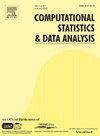Small area prediction of counts under machine learning-type mixed models
IF 1.6
3区 数学
Q3 COMPUTER SCIENCE, INTERDISCIPLINARY APPLICATIONS
引用次数: 0
Abstract
Small area estimation methods are proposed that use generalized tree-based machine learning techniques to improve the estimation of disaggregated means in small areas using discrete survey data. Specifically, two existing approaches based on random forests - the Generalized Mixed Effects Random Forest (GMERF) and a Mixed Effects Random Forest (MERF) - are extended to accommodate count outcomes, addressing key challenges such as overdispersion. Additionally, three bootstrap methodologies designed to assess the reliability of point estimators for area-level means are evaluated. The numerical analysis shows that the MERF, which does not assume a Poisson distribution to model the mean behavior of count data, excels in scenarios of severe overdispersion. Conversely, the GMERF performs best under conditions where Poisson distribution assumptions are moderately met. In a case study using real-world data from the state of Guerrero, Mexico, the proposed methods effectively estimate area-level means while capturing the uncertainty inherent in overdispersed count data. These findings highlight their practical applicability for small area estimation.
机器学习混合模型下计数的小面积预测
提出了一种小区域估计方法,该方法使用基于广义树的机器学习技术来改进使用离散调查数据的小区域分解均值的估计。具体来说,现有的两种基于随机森林的方法——广义混合效应随机森林(GMERF)和混合效应随机森林(MERF)——得到了扩展,以适应计数结果,解决了过度分散等关键挑战。此外,三种bootstrap方法旨在评估点估计器的可靠性为区域水平的平均值进行了评估。数值分析表明,MERF不假设泊松分布来模拟计数数据的平均行为,在严重过分散的情况下表现出色。相反,GMERF在适度满足泊松分布假设的条件下表现最佳。在使用来自墨西哥Guerrero州的真实数据的案例研究中,所提出的方法有效地估计了面积水平的平均值,同时捕获了过度分散计数数据中固有的不确定性。这些发现突出了它们在小面积估计中的实际适用性。
本文章由计算机程序翻译,如有差异,请以英文原文为准。
求助全文
约1分钟内获得全文
求助全文
来源期刊

Computational Statistics & Data Analysis
数学-计算机:跨学科应用
CiteScore
3.70
自引率
5.60%
发文量
167
审稿时长
60 days
期刊介绍:
Computational Statistics and Data Analysis (CSDA), an Official Publication of the network Computational and Methodological Statistics (CMStatistics) and of the International Association for Statistical Computing (IASC), is an international journal dedicated to the dissemination of methodological research and applications in the areas of computational statistics and data analysis. The journal consists of four refereed sections which are divided into the following subject areas:
I) Computational Statistics - Manuscripts dealing with: 1) the explicit impact of computers on statistical methodology (e.g., Bayesian computing, bioinformatics,computer graphics, computer intensive inferential methods, data exploration, data mining, expert systems, heuristics, knowledge based systems, machine learning, neural networks, numerical and optimization methods, parallel computing, statistical databases, statistical systems), and 2) the development, evaluation and validation of statistical software and algorithms. Software and algorithms can be submitted with manuscripts and will be stored together with the online article.
II) Statistical Methodology for Data Analysis - Manuscripts dealing with novel and original data analytical strategies and methodologies applied in biostatistics (design and analytic methods for clinical trials, epidemiological studies, statistical genetics, or genetic/environmental interactions), chemometrics, classification, data exploration, density estimation, design of experiments, environmetrics, education, image analysis, marketing, model free data exploration, pattern recognition, psychometrics, statistical physics, image processing, robust procedures.
[...]
III) Special Applications - [...]
IV) Annals of Statistical Data Science [...]
 求助内容:
求助内容: 应助结果提醒方式:
应助结果提醒方式:


